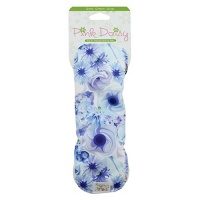Absorbency
- high absorbency for a panty liner!
- Trim as a day pad
- Ideal for light incontinence
Pink Daisy Small Organic Cotton Pads Overview
Pink Daisy Small Organic Cotton pads are amazingly soft but also wonderfully absorbent. Pink Daisy Organic Cotton is a velour fabric which is ideal for gushy, heavy periods and clots as it's a grippy fabric. The hidden layer of microfiber terry provides maximum absorbency and helps speed up drying. Breathable laminated polyester backing prevents leakage.
Pink Daisy Small Menstrual Pads are an unusual size. The small size pad is a mix between a heavy duty panty liner and a small regular day pad. The pad is definitely not as small or as thin as most of our panty liners but it's also not as long as a regular day pad which is why we keep the small pad in both categories.
So who is this pad for?
As a Panty Liner - If you are looking for a light absorbency panty liner these are NOT for you. If you prefer a heavy absorbency panty liner maybe for light incontinence then these are fabulous.
As a Menstual Pad - If your periods are quite light then this is also a fabulous pad as you don't need to have a pad as long or as big as most of the other brands of regular pads.
The natural cotton top is perfect if you have sensitive skin. Some people myself included get itchy with fleece but these pads are fleece free so no itchyness to worry about. Being a natural top they are more prone to staining so make sure you rinse out after use to help minimise stains setting.
Size
Size 8x3"
Which way up?
Plain side up.
Pink Daisy menstrual pads are made by one of the leading USA ethical brands Blueberry. Pink Daisy pads are high quality and available in beautiful prints.
Materials
Waterproof layer: 100% polyester laminate
Hidden layer: 100% polyester
How to use
Wash your Pink Daisy pads prior to first use. Snap pads around your underwear so the tag side faces down. Change pad every 2-6 hours or as needed. Wash per care instructions. Avoid washing the pads in public facilities. Pink Daisy pads are meant for personal use only, and should not be shared with others.
General wash & care instructions
Rinse or soak in cold water after changing pads or while waiting for wash day. This will keep stains from setting on your pads. Hand or machine wash cold or warm cycle. Line dry or tumble dry.
Do not use fabric softener. It will coat the pads and make them water repellent and reduce their absorbency. Be aware that if you use dryer sheets in your dryer for other laundry this can coat your dryer and transfer to your pads.
Do not use bleach. This will cause the fabric's fibers to break down. It will also cause the waterproof layer of the pad to de-laminate.
Stains. Should staining occur, try laying your pads out in the sun.
Read the our full article on how to wash and care for your cloth sanitary pads.
How many pads do I need?
As a general guide for a:
- short and light cycle 6 daytime and 3 night time
- Average length and flow 10 day pads and 4-5 night pads
- Longer and heavier cycles 15 day pads and 6-7 night time pads.
How To Wash Cloth Pads
Washing reusable cloth pads in the washing machine is the most effective way to care for your pads
Here is a basic guide to wash pads:
- When you remove your used pads rinse them thoroughly with cold water till the water runs clear. You can gently rub them to help remove as much blood as possible.
- Either pop them in your normal washing with other clothes or store them in a wet bag until wash day.
- Wash on a cold wash at either 30 or 40deg. You can use your normal detergent but avoid fabric softener.
Most companies will advise you to avoid harsh chemicals, fabric conditioner and tumble drying, as eventually it will lead to a shorter life span and issues with performance.
How To Dry Reusable Sanitary Pads
Ideally air dry your cloth sanitary pads and avoid using a tumble dryer. This helps to keep your reusable pads in better condition and is more environmentally friendly. A “sock” airer is ideal for drying them and can be hung inside in winter for quick drying. Most pads will easily dry overnight. Some pads can be tumble-dried, but this should be done on low and is best avoided as tumble drying can shrink some fabrics and remove fibres (that’s what the fluff is in the filter.)
How long will my pads last until I need to buy more to replace them?
As a general rule our suppliers expect their pads to last 5-10 years with average wear.








